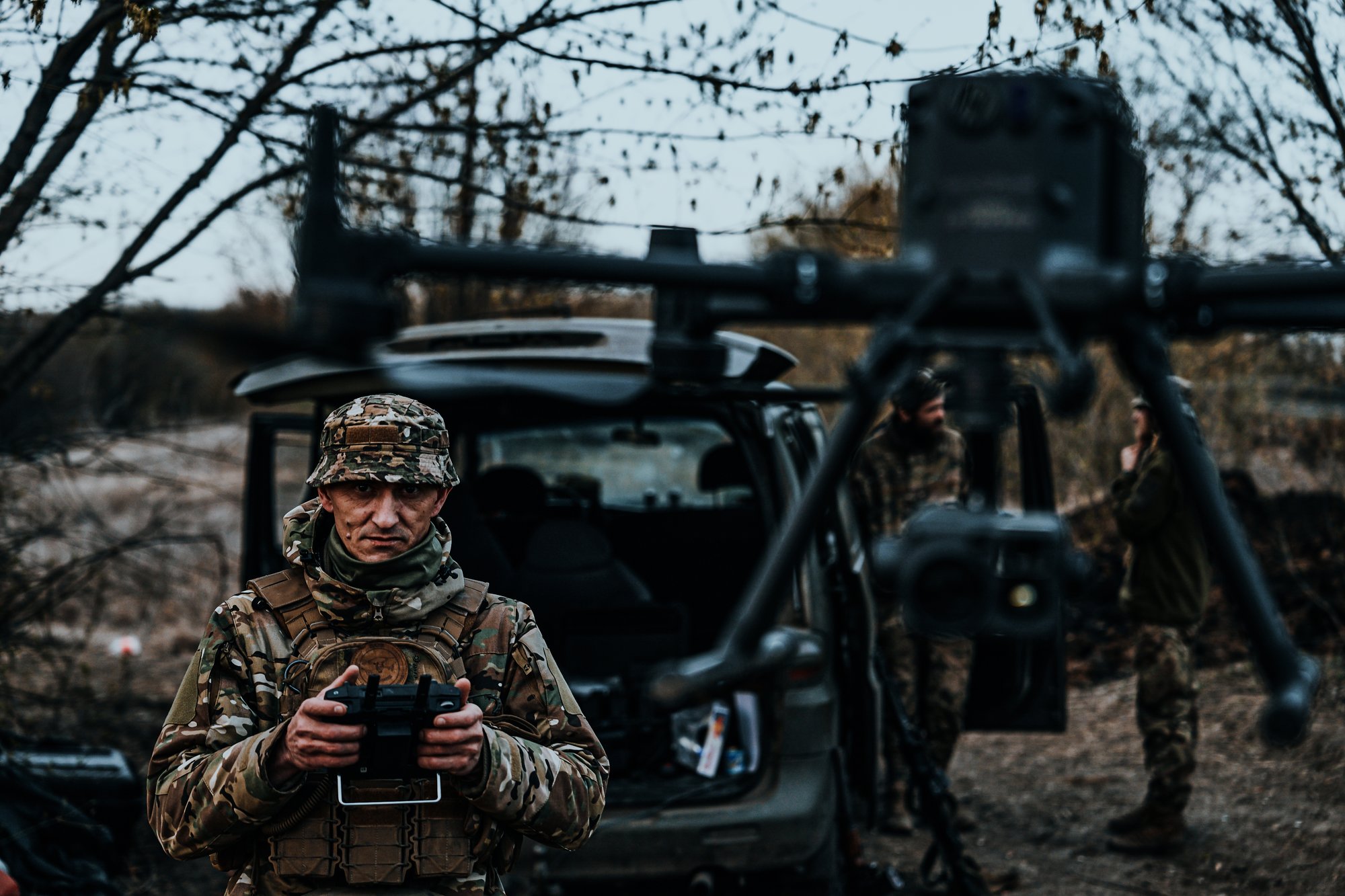
A Ukrainian soldier launches a drone in the area of the heaviest battles with Russian troops in Bakhmut, Donetsk region, Ukraine, Sunday, April 9, 2023. AP photo by Libkos.
When Stephen Townsend, a retired Army general, learned that a suicide drone “of Iranian origin” had killed one American contractor and wounded several US servicemembers at a base in Syria on March 23, 2023, his immediate response was one of abject frustration.
Townsend had been warning the Department of Defense for years that small, armed drones posed a major threat to American forces, and he repeatedly pushed for a “national effort” to develop better drone defenses on par with previous programs to counter improvised explosive devices, or IEDs, in Iraq and Afghanistan. Yet, because America has never suffered a catastrophic drone attack, there just hasn’t been enough “energy” within the Pentagon to spur such a major investment, Townsend said.
“I think we’re moving as fast as a peace-time bureaucracy is willing to move on this, but we’re still not moving at the speed of war,” Townsend told Coffee or Die. “And that is very frustrating to me.”
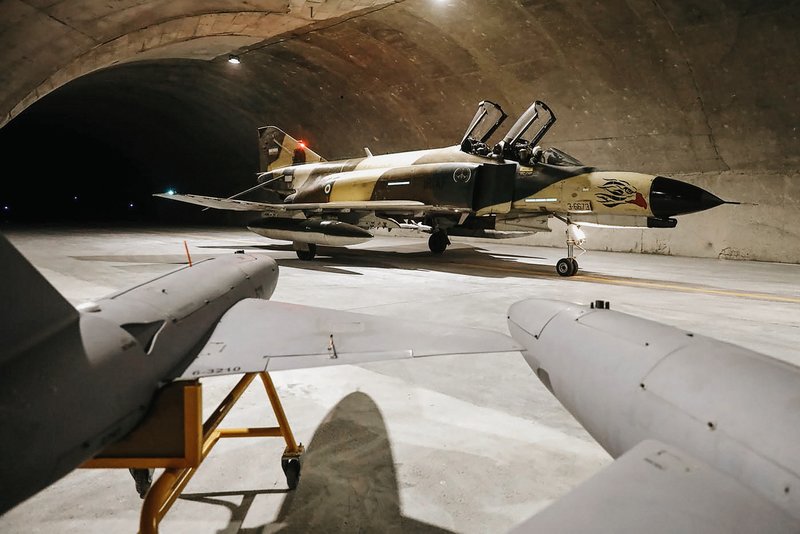
In this picture released Feb. 7, 2023, by the official website of the Iranian Army, a fighter jet taxis as two drones are seen in the foreground in Oghab-44, or Eagle-44, underground airbase in an undisclosed location in Iran. Iranian Army via AP.
While he was the commander of Operation Inherent Resolve, the international task force against the Islamic State, during the 2016 to 2017 Battle of Mosul, Townsend saw firsthand how the enemy’s armed drones nearly sapped the Iraqis’ will to fight. Then, as the commander of US Africa Command from 2019 to 2022, Townsend was often shocked to learn how drones, operated by an assortment of terrorist groups, were able to fly near US forces with virtual impunity.
Meanwhile, for the past 14 months, Russia’s full-scale invasion of Ukraine has foreshadowed the novel threats US forces will face from drones in any future conflict.
Despite new investment in counter-drone research and development since 2019, Townsend said the Pentagon is still not working fast enough to develop workable and cost-effective defense systems against small and medium-sized armed drones that range from the jury-rigged quadcopters Islamic State used in Mosul to the Iranian-made Shahed-136 drones that Russia often employs in Ukraine.
“Ukraine is this perfect example of what’s going to happen with us,” Townsend said. “Drones are ubiquitous now on the battlefield. High-end drone capabilities will be part of any enemy’s air campaign against us. We haven’t had to deal with that spectrum of threats yet, and I’m not sure we’re moving as fast as we can. That’s the bottom line.”
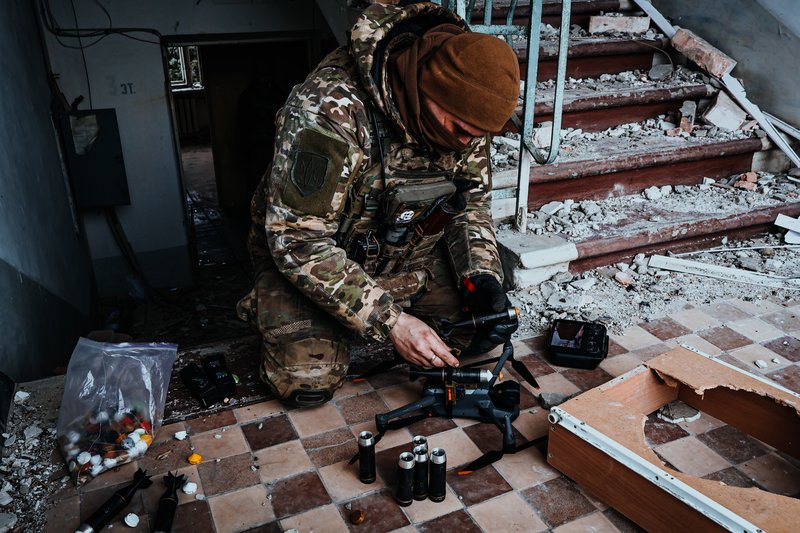
A Ukrainian soldier equips a drone with grenades in the area of the heaviest battles with the Russian invaders in Bakhmut, Donetsk region, Ukraine, Wednesday, March 15, 2023. AP photo by Roman Chop.
The Battle of Mosul
In November 2016, about one month into the Battle of Mosul, the Islamic State ramped up its drone attacks. What began as a tactical nuisance quickly transformed into an omnipresent, lethal menace that nearly broke the Iraqis’ will to fight.
“It’s hard to call something a ‘tactical nuisance’ when it’s killing people,” Townsend said. “At one point, the Iraqis told us to solve this problem or we’re not going to attack. They just assumed that America must have a magic wand, and I kept telling them we actually don’t.”
Between November 2016 and February 2017, Islamic State’s drone attacks became more intense and more sophisticated. The militants equipped their drones to drop 40mm grenades with drogue parachutes attached, as well as 60mm mortar rounds. They also used jury-rigged drones to drop Russian RKG anti-tank grenades, which have enough explosive power to punch through armor.
As time went on, the Islamic State’s drone attacks cast an inescapable specter of danger over the battlefield in Mosul. There was simply no escaping the threat from above, and that constant risk took a psychological toll on the Iraqis.
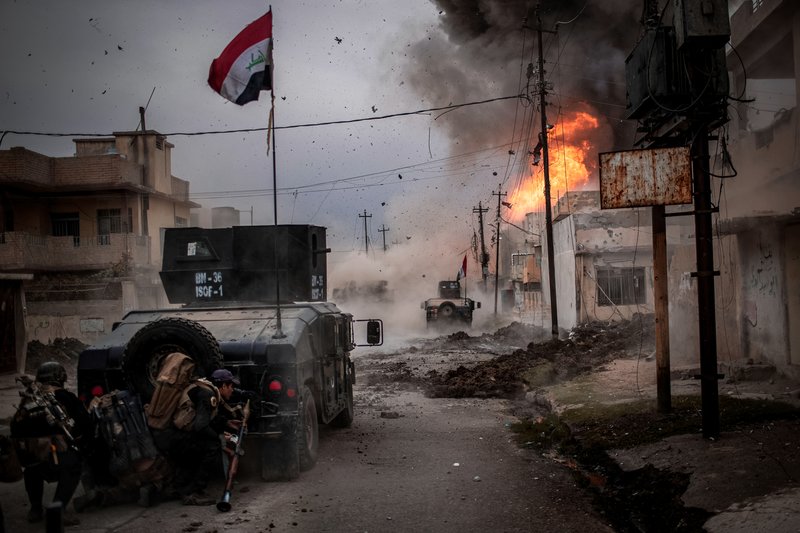
In this Nov. 16, 2016, file photo, a car bomb explodes next to Iraqi special forces armored vehicles as they advance toward Islamic State-held territory in Mosul, Iraq. AP photo by Felipe Dana.
“ISIS started deploying these things in swarms,” Townsend said. “One day we had 12 quadcopters attack us simultaneously on the battlefield in Mosul — that was the day that broke the camel’s back with the Iraqis.”
After a series of close calls involving American troops, and with the Iraqis nearly frozen out of the fight due to drone attacks, Townsend repeatedly sounded the alarm, trying to spur the Pentagon to develop and field better counter-drone defenses. Yet, his efforts failed to spark the changes he wanted.
“We had US troops wounded, we had partners killed in action, and I had certainly Iraqi and Syrian partners killed in action by enemy drones,” Townsend said. “But no US troops were killed … so I never thought it rose to the level to get Washington moving.”
After an Islamic State drone in Mosul killed special operations soldiers from a NATO ally, Townsend, who had grown increasingly frustrated by then, relayed a clear and chilling message to US Central Command and the Pentagon.
“I was using pretty blunt and stark language,” he recalled of that missive. “I told them, ‘American troops are gonna die. It’s going to happen any day now. We need to get on top of this problem. This is the IED of our time, right now.’”
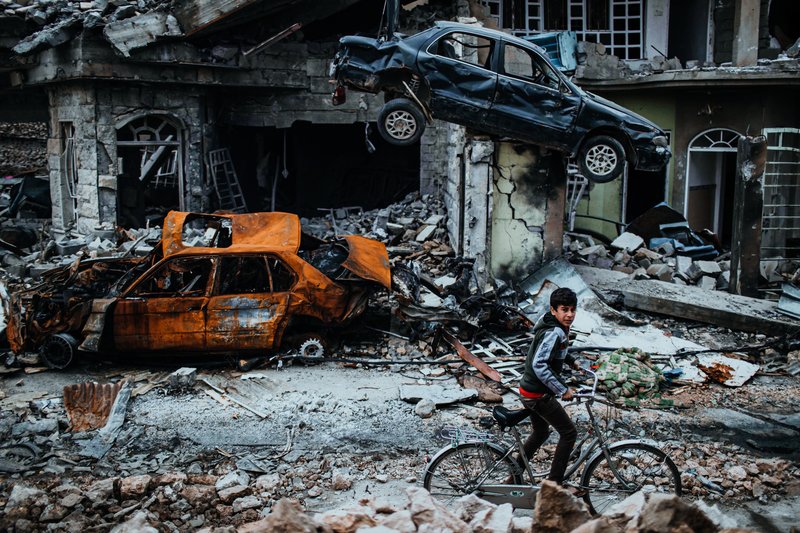
A boy rides his bike past destroyed cars and houses in a neighborhood liberated by Iraqi security forces on the western side of Mosul, Iraq, Sunday, March 19, 2017. AP photo by Felipe Dana.
The Ukrainian Crucible
The prolific use of battlefield drones in Ukraine, by both sides, has foreshadowed the roles of drones in future conflicts — not just against terrorist groups, but also against great power adversaries, such as China and Russia.
“The Russians are engaging in aerial terror on a scale and scope we really haven’t seen before. Particularly with autonomous aircraft,” John Parachini, a senior international and defense researcher for the Rand Corp., told Coffee or Die.
As far back as the summer of 2014, Ukrainian units jury-rigged commercial, off-the-shelf drones for surveillance use. They also used them to drop small munitions on their enemies.
In the summer of 2015, one front-line Ukrainian unit filled empty Monster energy drink cans with explosives, and then attached a tail fin made from a 3D printer to complete an improvised bomb to be dropped from small, commercially available quadcopter drones.

A Ukrainian soldier holds an anti-drone gun in a trench on the frontline in Bakhmut, Donetsk region, Ukraine, Monday, April 10, 2023. AP photo by Libkos.
For their part, the Russians also adapted small drones for reconnaissance and dropping weapons years before the full-scale invasion. Consequently, the Ukrainians became much more cautious. They avoided gathering outside, especially in clear weather, and they camouflaged their trenches and dugouts from aerial reconnaissance. During winter, after the leaves fell and there was less natural concealment, Ukrainian troops paid particular attention to concealing their movements and positions.
Beyond the front lines, Russia wields its arsenal of Iranian-made, Shahed-136 exploding drones to attack critical infrastructure sites across Ukraine and to terrorize civilians. Those strikes also intend to deplete Ukraine’s reserves of air defense missiles, which are needed to defend against more advanced air threats, such as cruise missiles and manned aircraft.
Parachini said drones have allowed Russia to mount mass aerial attacks on par with massed bombing raids in previous wars, without the resultant risk of mass casualties among its aircrews.
“We are in a new age of warfare,” Parachini said. “Air defense has always been important, but we were always focused on piloted aircraft. That needs to change.”

A Ukrainian soldier holds an anti-drone gun in a trench on the frontline in Bakhmut, Donetsk region, Ukraine, Monday, April 10, 2023. AP photo by Libkos.
The MacGyver Mentality
Most counter-drone technologies break down into either directed energy systems or kinetic air defenses. Directed energy weapons operate by interfering with the electronic communication signals between a drone and its ground operator, or by frying a drone’s controls. Kinetic weapons are the blunt force option — using air defense missiles, cannons, and machine guns to shoot down drones.
As the Battle of Mosul raged in the early months of 2017, the Pentagon ultimately sent US forces a hodgepodge of counter-drone systems — including both kinetic and directed energy options.
Yet, according to Townsend, many of these systems proved ineffective on the battlefield. One technology, the Anti-Drone Defense System, or AUDS, worked well enough, but it was built to work from a fixed site — a serious limitation in the dynamic, street-by-street nature of urban combat in Mosul.
“That was great because it worked, but we weren’t being attacked on our bases,” Townsend said about AUDS. “Now we were mobile, we were on the offense, and it was the front-line troops who were being attacked. And our mobile systems were not working, for a variety of reasons.”
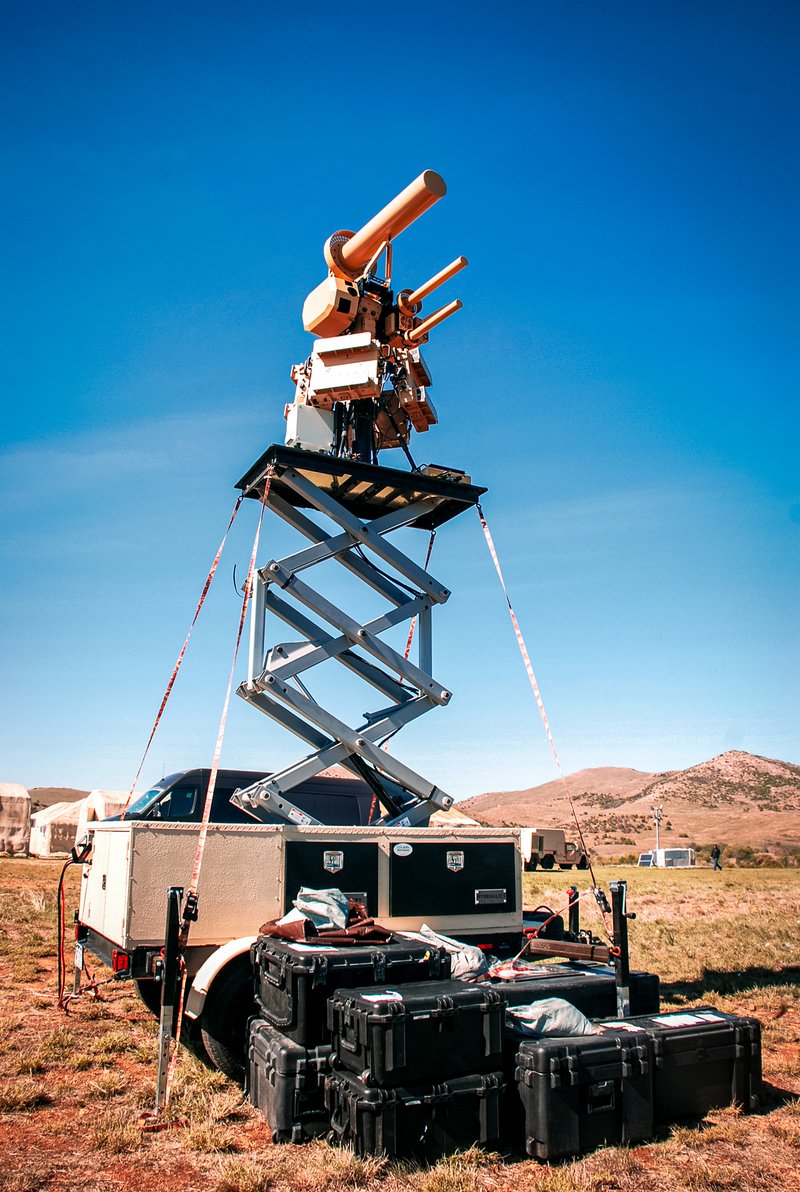
An anti-unmanned aerial vehicle defense system (AUDS) searches the skies of Fort Sill for UAVs on April 6, 2017, during the Maneuver Fires Integrated Experiment (MFIX). US Army photo by Monica K. Guthrie/Fort Sill Public Affairs.
Recognizing the need for an immediate solution, two US Army personnel under Townsend’s command — a captain and a sergeant first class — stayed up for an entire night and disassembled the AUDS from its fixed-site mounts. In one marathon push, they then reconstructed an improvised configuration that could be driven around the battlefield in a tactical truck while its control station operated from the back of an MRAP tactical vehicle.
“They MacGyvered the shit out of that thing,” Townsend said. “Thanks to their brilliant thinking, the damn thing worked. They drove to Mosul and started knocking down drones with that thing. It worked, and it kept the Iraqis in the fight. It helped them get past that psychological barrier.”
The DroneHunter
Following his time in command of Operation Inherent Resolve, Townsend assumed leadership of US Africa Command, or AFRICOM, in 2019. During that three-year leadership stint, Townsend once again pushed the Pentagon to develop better counter-drone defenses.
“I had unknown UAVs operating all around our troops in Africa, and there was little that we could do about it,” Townsend said, referring to unmanned aerial vehicles, or UAVs. “In AFRICOM, drones were frustrating because of the potential dangers I saw.”

The DroneHunter is a counter-UAS weapon produced by Fortem Technologies. Manufacturer photo.
Despite the constant menace, those drones never killed Americans and never destroyed American hardware in Africa. Thus, Townsend again faced bureaucratic headwinds as he pressed the Pentagon for better counter-drone defenses.
Like in the Battle of Mosul, Townsend said that some of the counter-drone systems his AFRICOM units received simply didn’t work. Moreover, they were piecemeal solutions, not designed to operate as congruent parts of an integrated air defense network.
“We were always putting these Band-Aid solutions together to make it work,” Townsend said. “In Africa, [drones] never became an operational impediment. But I knew that if US troops started dying from these things, then things would change.”
To develop better counter-drone defenses, the Pentagon established the Joint Counter-Unmanned Aircraft Systems Office, or JCO, in 2019. Despite some progress in developing new technologies, the drone threat in Africa underscored the limitations of America’s drone-defense options.
At bases near urban areas, or when defending airfields, it was often too risky to use kinetic options due to the risk of collateral damage. Even directed energy weapons risked a drone careening into a populated area or into a piece of valuable hardware, such as a multi-million-dollar military aircraft parked on an airfield ramp.
Further complicating matters, many US bases in Africa are located at military and civilian airfields, thereby precluding the use of GPS jamming or other directed-energy options that might interfere with manned aircraft operations.
With those constraints in mind, Townsend praised Fortem Technologies’ DroneHunter system, which uses a net and parachutes to bring down captured drones in a controlled way that limits risks to people and equipment on the ground. The DroneHunter is also agile and able to be transported by two troops on the battlefield. The need for that kind of mobility was one of the key lessons in anti-drone operations that Townsend gleaned from the Battle of Mosul.
“The DroneHunter is the gap between directed energy and kinetic systems,” Townsend said. “What I like about the DroneHunter is that it is mobile … it can be carried on a couple soldiers’ backs if it has to. But, most importantly, the DroneHunter can be used in sensitive environments where you’re worried about collateral damage.”
Based in Pleasant Grove, Utah, Fortem Technologies is a leader in commercial counter-drone defenses, including cutting-edge, small radars specially designed to detect drones. Ukraine has already fielded several of the company’s DroneHunter systems in combat — to intercept small drones on the front lines, as well as the larger, Iranian-made drones Russia uses to target critical infrastructure and civilian areas.
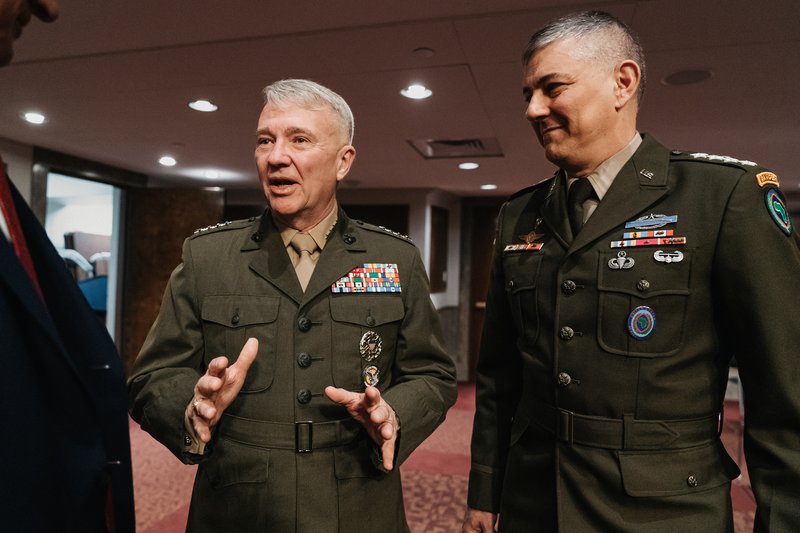
Gen. Kenneth McKenzie, commander of the United States Central Command, left, and Gen. Stephen Townsend, commander of the United States Africa Command, arrive to testify before the Senate Armed Services Committee as the panel holds a hearing on the readiness of the military in Africa and the Middle East, at the Capitol in Washington, Tuesday, March 15, 2022. Townsend is a vocal advocate for counter-drone defense. AP photo by J. Scott Applewhite.
In a hypothetical air war against a conventional military, the US military will face similar threats. For that reason, Townsend said the Pentagon should install counter-drone defenses, such as Fortem’s DroneHunter, at its bases across the world, as well as within the US homeland.
“This problem set straddles both conventional and unconventional warfare,” Townsend said. “Having just left Africa, I know that US troops are vulnerable to this threat, the lower-range threat in particular, which can be just as deadly.”
A New Kind of Terror
American veterans of the wars in Iraq and Afghanistan are well-acquainted with indirect fire threats. Insurgents in both those wars often fired rocket or mortar potshots at American bases, sometimes to lethal effect. Yet, the attacks were rarely precise, and a popular adage among US personnel was that the safest place to be during a Taliban rocket attack was smack in the center of their aimpoint.
The risk was primarily statistical. And while the odds of being in the wrong place at the wrong time were never zero, they were pretty low, and the psychological strain was usually bearable for deployed US servicemembers. The threat of armed drones, however, is a different story.
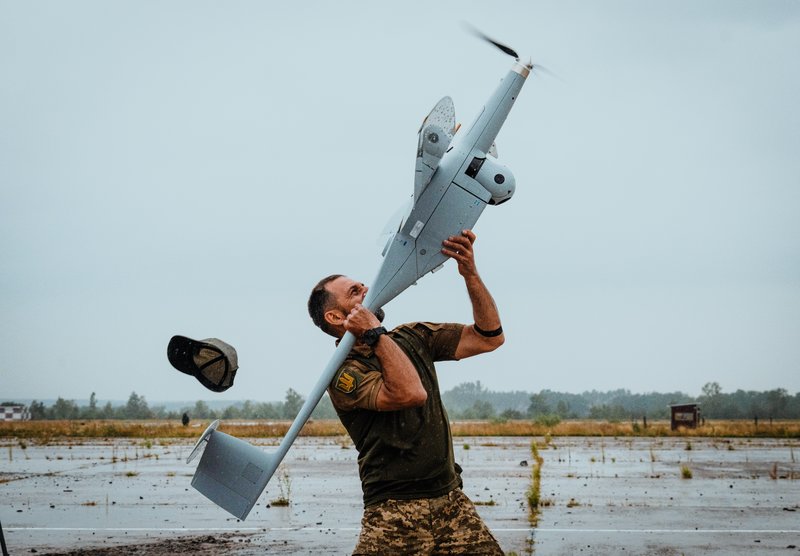
A Ukrainian soldier launches FlyEye WB Electronics SA, a Polish reconnaissance drone, which is in service with the Ukrainian army, in Kyiv region, Ukraine, Tuesday, Aug. 2, 2022. A spate of drone attacks that Russian authorities blamed on Ukraine has targeted areas in southern and western Russia, reflecting the Ukrainian military's growing reach as the war dragged into a second year. AP photo by Efrem Lukatsky, file.
“The most dangerous thing about indirect-fire is when they have a forward observer … and that’s exactly what an armed UAV is,” Townsend said.
Compared to traditional indirect-fire threats, there is a vast difference, in terms of psychological impact, when you understand that a drone is trying to kill you — specifically, you. Drones can track you and wait for you to emerge from a hiding place. They can arrive in swarms or in solo sneak attacks.
The most terrifying aspect of drone attacks, however, is the feeling that you’re always being watched and that an attack could come at any time, without warning.
The threat from Russian armed drones has imposed a psychological strain on Ukrainian soldiers for years. At a front-line post near Luhansk in October 2021, a Ukrainian lieutenant named Illia told this correspondent: “It puts you under constant pressure when you always expect something from the air. You can never relax.”
“Soldiers fear the drone threat more than the indirect-fire threat,” Townsend said. “I can hide from indirect-fire threats, but it’s much harder to hide from a UAV. The UAV can chase you. The drone can literally chase you. That’s a helpless feeling — to know he’s watching you, and he’s coming for you.”
Read Next: Rocket Power: M270 MLRS Brings the Rain

BRCC and Bad Moon Print Press team up for an exclusive, limited-edition T-shirt design!
BRCC partners with Team Room Design for an exclusive T-shirt release!
Thirty Seconds Out has partnered with BRCC for an exclusive shirt design invoking the God of Winter.
Lucas O'Hara of Grizzly Forge has teamed up with BRCC for a badass, exclusive Shirt Club T-shirt design featuring his most popular knife and tiomahawk.
Coffee or Die sits down with one of the graphic designers behind Black Rifle Coffee's signature look and vibe.
Biden will award the Medal of Honor to a Vietnam War Army helicopter pilot who risked his life to save a reconnaissance team from almost certain death.
Ever wonder how much Jack Mandaville would f*ck sh*t up if he went back in time? The American Revolution didn't even see him coming.
A nearly 200-year-old West Point time capsule that at first appeared to yield little more than dust contains hidden treasure, the US Military Academy said.












